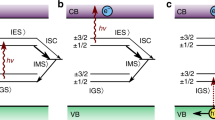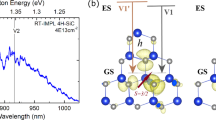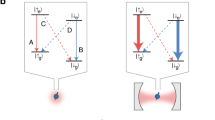Abstract
The detection of electron spins associated with single defects in solids is a critical operation for a range of quantum information and measurement applications under development1,2,3,4,5,6,7,8,9. So far, it has been accomplished for only two defect centres in crystalline solids: phosphorus dopants in silicon, for which electrical read-out based on a single-electron transistor is used1, and nitrogen–vacancy centres in diamond, for which optical read-out is used4,5,6. A spin read-out fidelity of about 90 per cent has been demonstrated with both electrical read-out1 and optical read-out10,11; however, the thermal limitations of the former and the poor photon collection efficiency of the latter make it difficult to achieve the higher fidelities required for quantum information applications. Here we demonstrate a hybrid approach in which optical excitation is used to change the charge state (conditional on its spin state) of an erbium defect centre in a silicon-based single-electron transistor, and this change is then detected electrically. The high spectral resolution of the optical frequency-addressing step overcomes the thermal broadening limitation of the previous electrical read-out scheme, and the charge-sensing step avoids the difficulties of efficient photon collection. This approach could lead to new architectures for quantum information processing devices and could drastically increase the range of defect centres that can be exploited. Furthermore, the efficient electrical detection of the optical excitation of single sites in silicon represents a significant step towards developing interconnects between optical-based quantum computing and silicon technologies.
This is a preview of subscription content, access via your institution
Access options
Subscribe to this journal
Receive 51 print issues and online access
$199.00 per year
only $3.90 per issue
Buy this article
- Purchase on Springer Link
- Instant access to full article PDF
Prices may be subject to local taxes which are calculated during checkout



Similar content being viewed by others
References
Morello, A. et al. Single-shot readout of an electron spin in silicon. Nature 467, 687–691 (2010)
Fuechsle, M. et al. A single-atom transistor. Nature Nanotechnol. 7, 242–246 (2012)
Pla, J. J. et al. A single-atom electron spin qubit in silicon. Nature 489, 541–545 (2012)
Gaebel, T. et al. Room-temperature coherent coupling of single spins in diamond. Nature Phys. 2, 408–413 (2006)
Jiang, L. et al. Repetitive readout of a single electronic spin via quantum logic with nuclear spin ancillae. Science 326, 267–272 (2009)
Togan, E. et al. Quantum entanglement between an optical photon and a solid-state spin qubit. Nature 466, 730–734 (2010)
Maze, J. R. et al. Nanoscale magnetic sensing with an individual electronic spin in diamond. Nature 455, 644–647 (2008)
Morton, J. J. L., McCamey, D. R., Eriksson, M. A. & Lyon, S. A. Embracing the quantum limit in silicon computing. Nature 479, 345–353 (2011)
Zwanenburg, F. A. et al. Silicon quantum electronics. Preprint at http://arxiv.org/abs/1206.5202 (2012)
Robledo, L. et al. High-fidelity projective read-out of a solid-state spin quantum register. Nature 477, 574–578 (2011)
Neumann, P. et al. Single-shot readout of a single nuclear spin. Science 329, 542–544 (2010)
Steger, M. et al. Quantum information storage for over 180 s using donor spins in a 28Si “semiconductor vacuum”. Science 336, 1280–1283 (2012)
Kenyon, A. J. Erbium in silicon. Semicond. Sci. Technol. 20, R65 (2005)
Vinh, N. Q., Ha, N. N. & Gregorkiewicz, T. Photonic properties of Er-doped crystalline silicon. Proc. IEEE 97, 1269–1283 (2009)
Bertaina, S. et al. Rare-earth solid-state qubits. Nature Nanotechnol. 2, 39–42 (2007)
Baldit, E. et al. Identification of Λ-like systems in Er3+:Y2SiO5 and observation of electromagnetically induced transparency. Phys. Rev. B 81, 144303 (2010)
Kolesov, R. et al. Optical detection of a single rare-earth ion in a crystal. Nature Commun. 3, 1029 (2012)
Sun, Y., Thiel, C. W., Cone, R. L., Equall, R. W. & Hutcheson, R. L. Recent progress in developing new rare earth materials for hole burning and coherent transient applications. J. Lumin. 98, 281–287 (2002)
Priolo, F., Franz, G., Coffa, S. & Carnera, A. Excitation and nonradiative deexcitation processes of Er3+ in crystalline Si. Phys. Rev. B 57, 4443 (1998)
Pioda, A. et al. Single-shot detection of electrons generated by individual photons in a tunable lateral quantum dot. Phys. Rev. Lett. 106, 146804 (2011)
Hanson, R., Petta, J. R., Tarucha, S. & Vandersypen, L. M. K. Spins in few-electron quantum dots. Rev. Mod. Phys. 79, 1217–1265 (2007)
Sellier, H. et al. Subthreshold channels at the edges of nanoscale triple-gate silicon transistors. Appl. Phys. Lett. 90, 073502 (2007)
Tettamanzi, G. C. et al. Interface trap density metrology of state-of-the-art undoped Si n-FinFETs. IEEE Electron Device Lett. 32, 440–442 (2011)
Guillot-Nol, O. et al. Hyperfine interaction of Er3+ ions in Y2SiO5: an electron paramagnetic resonance spectroscopy study. Phys. Rev. B 74, 214409 (2006)
Hedges, M. P., Longdell, J. J., Li, Y. & Sellars, M. J. Efficient quantum memory for light. Nature 465, 1052–1056 (2010)
Simmons, S. et al. Entanglement in a solid-state spin ensemble. Nature 470, 69–72 (2011)
Smith, K. F. & Unsworth, P. J. The hyperfine structure of 167Er and magnetic moments of 143, 145Nd and 167Er by atomic beam triple magnetic resonance. Proc. Phys. Soc. 86, 1249 (1965)
McAuslan, D. L., Bartholomew, J. G., Sellars, M. J. & Longdell, J. J. Reducing decoherence in optical and spin transitions in rare-earth-metal-ion–doped materials. Phys. Rev. A 85, 032339 (2012)
Yang, S. et al. Electron paramagnetic resonance of Er3+ ions in aluminum nitride. J. Appl. Phys. 105, 023714 (2009)
Lansbergen, G. P. et al. Gate-induced quantum-confinement transition of a single dopant atom in a silicon FinFET. Nature Phys. 4, 656–661 (2008)
Sleiter, D. J. et al. Optical pumping of a single electron spin bound to a fluorine donor in a ZnSe nanostructure. Nano Lett. 13(1), 116–120 (2013)
Michel, J. et al. Impurity enhancement of the 1.54 μm Er3+ luminescence in silicon. J. Appl. Phys. 70, 2672–2678 (1991)
Ziegler, J. F., Ziegler, M. & Biersack, J. SRIM – The stopping and range of ions in matter (2010). Nucl. Instrum. Methods Phys. Res. B 268, 1818–1823 (2010)
Acknowledgements
We thank R. Ahlefeldt, J. Bartholomew, R. Elliman, N. Manson and A. Morello for discussions. We also thank M. Hedges and T. Lucas for their help in the initial phase of the experiments. The devices were fabricated by N. Collaert and S. Biesemans. This work was financially supported by the ARC Centre of Excellence for Quantum Computation and Communication Technology (CE110001027) and the Future Fellowships (FT100100589 and FT110100919).
Author information
Authors and Affiliations
Contributions
N.S. and J.C.M. designed and performed the implantation. C.Y., M.J.S. and S.R. designed and conducted the experiments. C.Y., M.R. and G.G.d.B. carried out the experiments. All the authors contributed to analysing the results and writing the paper.
Corresponding author
Ethics declarations
Competing interests
The authors declare no competing financial interests.
Rights and permissions
About this article
Cite this article
Yin, C., Rancic, M., de Boo, G. et al. Optical addressing of an individual erbium ion in silicon. Nature 497, 91–94 (2013). https://doi.org/10.1038/nature12081
Received:
Accepted:
Published:
Issue Date:
DOI: https://doi.org/10.1038/nature12081
This article is cited by
-
Emission enhancement of erbium in a reverse nanofocusing waveguide
Nature Communications (2023)
-
A solid-state quantum microscope for wavefunction control of an atom-based quantum dot device in silicon
Nature Electronics (2023)
-
Transition metal impurities in silicon: computational search for a semiconductor qubit
npj Computational Materials (2022)
-
Sub-50-ns ultrafast upconversion luminescence of a rare-earth-doped nanoparticle
Nature Photonics (2022)
-
An L-band emitter with quantum memory in silicon
npj Computational Materials (2022)
Comments
By submitting a comment you agree to abide by our Terms and Community Guidelines. If you find something abusive or that does not comply with our terms or guidelines please flag it as inappropriate.



